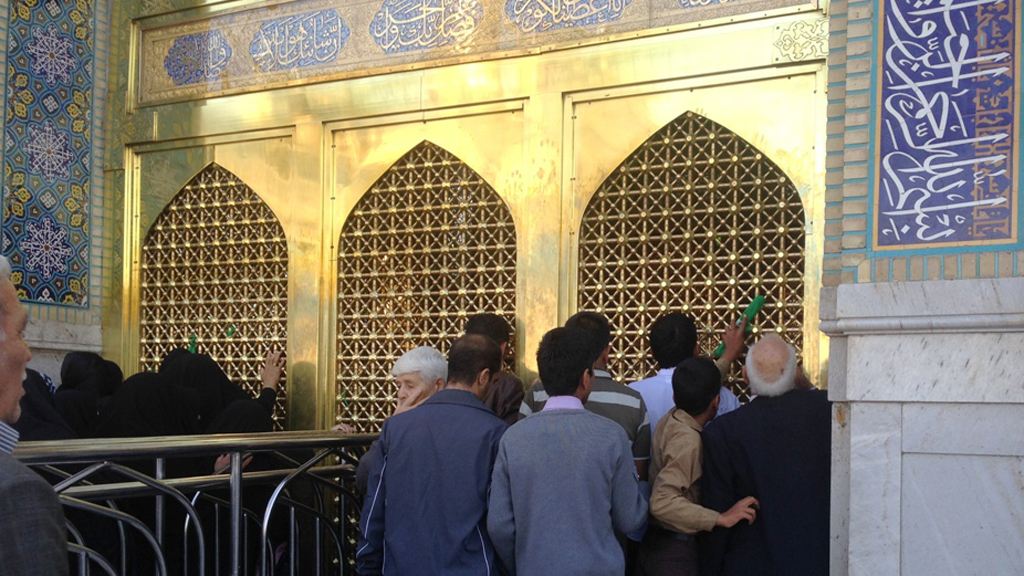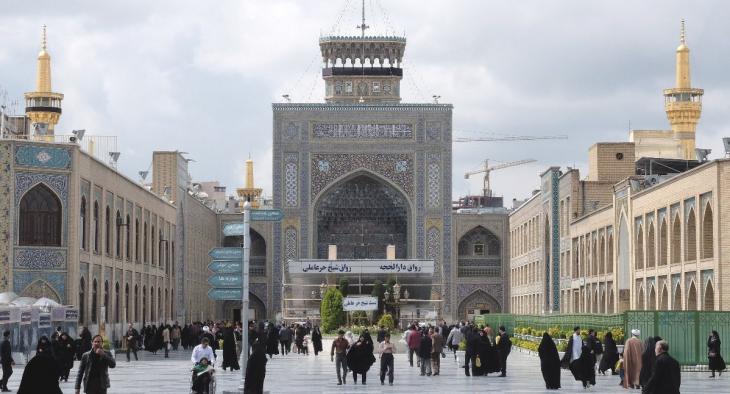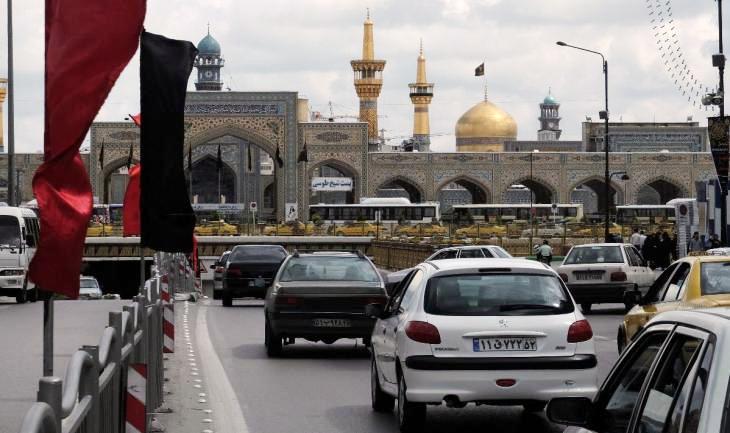Faith and profit enshrined

The air in the courtyards is still cool before the heat of the day: beneath the golden dome, the number of pilgrims attending the grave of Imam Reza is still manageable. Towards midday, it will no longer be possible to pass through here for the mass of people pushing forwards. The neverending stream of pilgrims does not let up and is guided around the tomb of the Imam by specific gestures given by black-uniformed guards. But just before sunrise, it is still quiet inside the Mashhad mausoleum, the most important pilgrimage site in Iran.
The tomb is like a beating heart that attracts pilgrims from the entire Shia world and keeps an ever-flowing stream of people in motion. It beats slower in the mornings and faster at midday, but it is never completely still. Pilgrims even visit the grave of the Eighth Shia Imam at night. The site draws 20 million pilgrims every year – from Iran, Iraq, Lebanon, the Gulf States and Afghanistan, which is just 200 kilometres away. That's an average 56,000 worshippers a day and considerably more on public holidays.
Closer to the ″light″ of God
In the rooms around the central burial chamber, the sparkling roof covered in a mosaic made of thousands of tiny mirrors, the men sit leaning against the marble-clad wall, an open book on the floor, prayer beads between their fingers. Segregated along gender lines, the men enter the chamber from one side, the women from the other, kissing the door frame, before pressing the forehead and lips against the bare metal of the grille that surrounds the grave – many of them with tears in their eyes.
Grieving for the martyr plays a key role in Shia Islam and when a preacher tells of the death of Imam Reza in the year 818 at the hands of the Caliph Al-Ma'mum, entire roomfuls of people demonstratively burst into sobs, as though it happened just yesterday. But for many pilgrims the emotion is real and the pilgrimage to Mashhad the fulfilment of a long-held dream. Visiting the shrine of the Imam enables them to share in the experience of the holy man – or as Mohsen describes it, it brings the faithful closer to the "light" of God's truth.

The young man in his mid-20s, who resembles former President Mahmud Ahmadinejad with his blue jacket, black collarless shirt and unshaven chin, is studying theology in Isfahan and hopes to enter the clergy. "Regular people cannot directly see the light of God and that is why God sent the 12 Imams to bring light to the people," says Mohsen and makes a gesture, as though trying to catch the light in his hands and offer it to someone.
Mohsen is a seeker – in search of the truth. "Every day I learn something new about God here," he says. He comes to Mashhad five or six times a year, to spend a few days at the tomb of the Imam, to study, to meditate and to be close to the "light" of God. He is still at the start of his journey; a journey he will never complete, says the theology student. But the gleam in his eyes suggests that he has at least found some of that divine light already.
Faith is the foundation's most important capital
While the internal rooms fill up with pilgrims, outside on the "Islamic Republic Courtyard", shrine staff are rolling out carpets for midday prayers. On the four sides of the courtyard, which is linked up with the burial chamber to the north, there are towering portals clad in blue, yellow and turquoise tiles, which form elaborate ornaments and calligraphic lines of writing, while the portal to the burial chamber is entirely covered in gold – an indication of the reverence of the Imam, as well as the wealth of the shrine.
The pilgrimage site is an important economic factor for Mashhad, but at the same time the shrine itself wields economic power with an influence in Iran that cannot be underestimated. Having attained enormous wealth through donations and gifts over the centuries, the Astan-e Qods-e Razavi Foundation that manages the shrine has since the 1979 Revolution grown into an extensive business empire that uses its capital in a blatantly profit-orientated manner, making large-scale investments in Iraq, Syria and Lebanon.Like few other institutions, the foundation shows just how closely interlinked faith, profit and power are in Iran: the piety of the people legitimises the religious regime and brings it financial gain that it can use to stabilise its power. Conversely, the regime invests in the religious infrastructure and promote pilgrimages to Mashhad and other holy sites, to justify to its claim to be the representative of the Imams and the defender of Islam and to spread its reading of the faith among the populace.
The shrine has undergone major developments since the 1979 Revolution. Numerous rooms and courtyards have been built in addition to the old halls and courtyards built by the Safavids and Qajars in the 17th and 19th centuries, to accommodate the rising number pilgrims; huge sanitary facilities, shopping malls and underground car parks have also been built. The developments have indeed served to enhance the overall efficiency of the complex, reports the architect and anthropologist Samar Saremi, who is carrying out research into the construction history of the shrine.
There was little difference between the handling of the shrine and other urban sites with transport and access issues, says the architect, citing the escalators integrated into the mediaeval architecture. Although the manner in which a pilgrim approaches a shrine – whether on foot or by car – changes the meaning of the act and the perception of the place, the predominant concern in the design was pragmatic access with the aim of organising the pilgrimage as efficiently as possible.

It is midday and the internal courtyards have filled with worshippers for midday prayers, the "brothers" on one side and chador-clad "sisters" on the other. While the call to prayer is issued from the rooftops, more pilgrims approach hurriedly via the shade-free outer courtyards, until all spaces on the carpet are taken up and the black-uniformed guards close off the internal area and wave the new arrivals through into the subterranean halls that were built beneath the old courtyards.
President Rouhani has neither insight nor control
At the exit, Keyvan waits for a tour through Mashhad. "Do you know another city where there is such a high concentration of hotels?" asks the civil engineer, as he weaves his car through the traffic, pointing at the hotel towers around the shrine. They all live from the pilgrims, many of them belong to Astan-e Qods. But that's not all: the foundation also owns shopping malls, factories, banks; it owns half of the real estate in this city of millions and most of the land in the surrounding province of Khorasan.
"The foundation takes what it wants by force," says Keyvan, not his real name. No one stands a chance if it raises a claim to a plot of land or building. The civil engineer with the rimless glasses and shaved head has never worked for it, because its contracts can only be won through contacts. The foundation is hated in the city, it does no charity work, says Keyvan. The foundation enjoys tax-free status and autonomy from the government.
Like the other religious foundations, Astan-e Qods is controlled by Supreme Leader Ayatollah Ali Khamenei, says Tubingen-based ethnologist Katharina Muller, who is conducting research into the structures of the foundation. But even Khamenei has only a limited say in the running of the foundation, while the government of President Hassan Rouhani has neither insight nor control. Muller emphasises that Astan-e Qods is not an executive organ of the government, but a self-contained, very self-confident political actor that pursues its own course in politics and business.
The long-time foundation chairman Ayatollah Abbas Vaez-Tabbasi, also described as the "Emperor of Khorasan" owing to his extensive powers, died last March. But it still remains to be seen whether Khamenei can tighten his control over the foundation. Although the new chairman Ebrahim Rais is unlikely to attain the position of his predecessor, a man who led Astan-e Qods since the 1979 Revolution, it is Muller’s view that the foundation will certainly make sure it safeguards its independence.

Reclusive and self-sufficient
The foundation sees itself as a guardian of the tradition and the values of the Islamic Revolution. It rejects a liberalisation of politics and culture and also takes a critical view of President Rouhani's efforts to open up the country's economy. This is also because such an opening would threaten the very existence of many of Astan-e Qods' companies and factories, as its economic model only functions as long as the nation is isolated and business is not exposed to international competition.
Keyvan steers his car back onto the subterranean ring road that encircles the shrine beneath the outer courtyards. In the fog of emissions and traffic noise, it's hard to imagine that the tomb of the Imam is just a few metres away. Most of the city's traffic travels along the multi-lane expressway, accessed from four sides via motorway-style feeder roads. The expressway also provides access to the subterranean car parks, from which the pilgrims can directly enter the shrine.
But Keyvan prefers to stay outside. Like many young Iranians, the 33-year-old is estranged from Islam. The shrine of Mashhad may show how strong the faith and how important Islam still is for many Iranians, but for years now, studies have also shown that religiosity in Iran is declining and that members of the young generation in particular are turning away from Islam in droves because of the political misuse of religion by the regime.
Keyvan is annoyed by the perpetual religious propaganda and weary of the continual presence of the mullahs in the media. He is unsettled by the fervour of the pilgrims, when they strike their chests, sobbing in grief at the death of the Imam and left cold by the beauty of the architecture, the rich gold of the dome, the deep blue of the portal. He only comes to the shrine once a year, when he accompanies his mother to pray. If faith is the capital of the foundation, Keyvan has no contribution to make.
Ulrich von Schwerin
© Qantara.de 2016
Translated from the German by Nina Coon